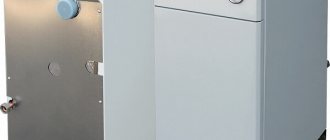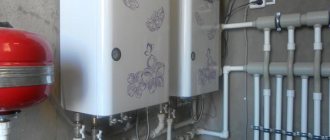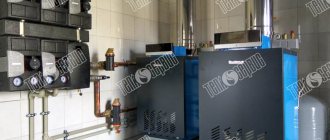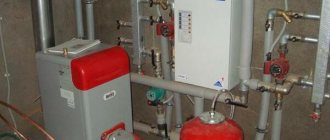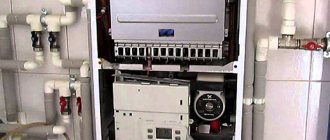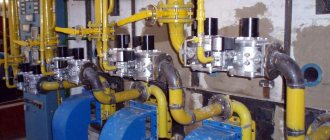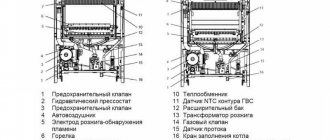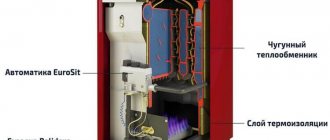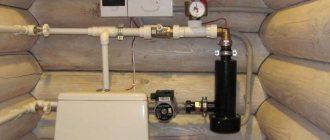Creating your own heating system can significantly reduce the cost of heating and hot water supply.
For owners of private houses, this is also an opportunity to independently determine the start and end time of the heating season, and adjust the heating mode according to their feelings and preferences, and not according to the operating conditions of public networks.
In addition, constantly growing housing and communal services tariffs are forcing us to look for alternative ways to solve problems with heat supply to housing.
To create autonomous heating systems, different types of boilers are used, but gas units are considered the most efficient.
Let's consider one of the examples of domestic heating equipment, which represents serious competition to European models - the Siberia gas boiler.
Gas boilers from Siberia
Siberia boilers are the brainchild of Rostovgazoapparat CJSC. The company produces a wide range of heating and water heating equipment; installations produced under the Siberia brand are far from the only models in the company’s arsenal.
The main advantage, which determines stable demand and high-quality operation of boilers, is a deep knowledge of the conditions and operating features of heating equipment in the countries of the former USSR.
The manufacturer has eliminated the most problematic areas in the design, creating non-volatile units capable of operating in the most difficult conditions . This advantage can only be truly appreciated by residents of Russia who have an understanding of winter frosts and the danger of being left without heating.
The company produces units that are optimally suited for use in small and medium-sized private houses, of which the vast majority are in our country. Low gas consumption and active use of natural physical processes make it possible to increase efficiency and simplify the design of units .
Manufacturer information
For ten years now, a company producing heating units has been mass-producing its products. Although its roots go back to 1888, when two factories merged. And 1959 was significant for the production of heating devices; the product was a prototype of modern AGV-80 models.
Over time, modifications were improved, and the AGV-120 model appeared in 1967, which was based on the old AGV-80 models. The production of both brands has survived to this day, which speaks of the reliability and quality of the product.
A well-known company is engaged in the production of boiler structures. She was awarded an Honorary Diploma during the presentation of the product at an international exhibition. And has been repeatedly awarded prizes for quality products.
The year 2005 was marked by the release of products under the Siberia brand. The developed modifications of this brand meet the quality, reliability and ease of use. Consumers actively use Siberia brand products.
Kinds
All Siberia units are floor-mounted. This allows you not to load the walls in residential premises and expands installation possibilities - floor-standing boilers can be placed anywhere, unlike wall-mounted structures .
Since the units are non-volatile, the type of gas burner is the same for all - open (atmospheric) type elements with natural smoke removal are installed (a conventional stove-type draft is used). This circumstance puts forward some requirements for the room - it is necessary to ensure high-quality ventilation and eliminate drafts.
The circulation of the coolant is also natural by default, which creates the need for proper installation of the heating system in compliance with the required slope of the pipelines.
However, it is possible to install an external circulation pump, which increases the speed of movement of the heating agent and significantly increases the overall efficiency of the boiler.
There are single- and double-circuit models. The former are intended only for preparing coolant in the heating circuit, the latter simultaneously heat batteries and hot water for household needs.
The second type of design is more preferable in a private home, but the gas consumption of such boilers is slightly increased.
IMPORTANT!
When choosing a boiler, you should calculate in advance the required volumes of hot water in order to obtain a system that gives the optimal effect.
The lineup
Floor-standing gas boiler Siberia 11K
The classic floor-standing boiler Siberia AOGV is part of a range of products that are compact in size and have a very reasonable price. Their range was expanded by releasing models with varying technical parameters (declared power and performance). Among them, economical models stand out, produced in versions of 11, 17 and 23 kW, as well as with higher power, reaching 35 kW. This series also includes dual-circuit models. The letter “K” (“Siberia 11K”) is usually added to the name of the latter. At the same time, they cost only 10-15% more than single-circuit models.
Experience in operating medium-power units (17 and 23 kW) has proven that they are among the most successful and reliable models produced by domestic manufacturers. However, they also have all the disadvantages already discussed, including sensitivity to contamination of components and coolant, as well as noisy ignition. Since the maximum permissible operating pressure of these models is no more than 1 bar, it is not recommended to use them in closed systems (in them the indicated indicator reaches 1.5-2 bars). The cost of boilers in this series varies between 19.8-26.0 thousand rubles.
KCHGO series
Gas floor boiler 16 Siberia KCHGO
One of the best examples presented on the market by the Siberia production association are boilers for heating a private home from the KCHGO series. Their main difference from previous models is as follows:
- large dimensions and weight of the product due to the cast iron heat exchanger;
- long service life (up to 30 years);
- higher permissible coolant pressure, which averages 3 bar;
- a wide selection of versions differing in declared power (16, 25, 40, and 50 kW).
Top Line Series
Wall-mounted gas boiler Siberia Top Line 24C
This series is represented by mounted models, in which all the necessary modules are already built-in: a safety group, an expansion tank, and a circulation pump. Their difference from other products is the presence of a modulating burner, which allows reducing gas consumption to 2.65 m3/hour (with an operating power of 24 kW). The heat exchanger of these models is made of copper, which has better thermal conductivity and is more resistant to corrosion than steel.
In double-circuit boilers, a dual circuit of coolant circulation is used, which significantly complicates the possibility of washing or cleaning it. Therefore, only soft and well-purified water is used as a coolant.
In addition to everything listed, these samples provide protection against overheating and freezing, as well as the ability to connect an external thermostat. The only drawback of these models is the difficulty of purchasing, since they are still rarely found in the assortment of online stores. Due to the lack of other versions, only single-circuit Top Line 24 kW is currently available. Their cost varies from 21,500-27,000 rubles.
Popular models
Siberia boilers are available in two design types:
- With cast iron heat exchanger. The series is marked with the designation KCHGO. Only single-circuit models with power
- With steel heat exchanger. Single- and double-circuit models are presented (the latter are marked with the letter “K” - combined).
The power of the models is designed for use in small and medium-sized private homes.
Value ranges include 11, 16, 23, 29, and 35 kW. Models with a cast iron heat exchanger also have 40 and 50 kW units, designed for operation in larger rooms . All models are equipped with an open type gas burner, which are manufactured in Italy.
Equipped with piezo or electronic ignition systems. To control pressure, capillary-type pressure gauges installed on the boiler body are used.
Brief overview of models
Of particular interest are Siberia gas floor-standing boilers with steel heat exchangers. This line is the best-selling and most practical, as confirmed by numerous certificates. In total, Siberia products are represented by 19 models:
- Floor and wall (11).
- Boilers with cast iron heat exchangers (4).
- Water heaters (4).
Technical equipment and design features
The heat exchanger of a gas boiler is made of high-carbon heat-resistant steel or thin-walled cast iron. A distinctive feature is the developed area of this design: water is heated not only by burning fuel, but also by using the thermal energy of combustion products. Siberia heaters are equipped with a gas atmospheric burner made of high-alloy steel, which is known for its strength and heat resistance. There are varieties with open and closed fireboxes; almost all boilers have a piezoelectric ignition system (the exception is those marked with the letter “i”).
The protective automation is designed as a separate unit, including:
- Magnetic valve.
- Built-in filter for cleaning gas fuel.
- Modulating thermostat for quick on/off function.
- Re-ignition blocking.
- Stabilizer for monitoring changes in pressure in the fuel supply line.
To insulate individual elements inside the body of a gas boiler, basalt fiber gaskets are used; the outer coating is made primarily of powder enamel; some cast iron varieties have a metal shell (stainless steel). In this way, the manufacturer protects the consumer from burns and injuries. Feedback from owners about the design and control panel is more than positive; it is widely believed that in terms of aesthetics and user-friendliness of the interface, Siberia is in no way inferior to its foreign counterparts.
The advantage of some models is the built-in function of replacing natural gas with liquefied gas; it protects the owner of a heated room in case of emergency breaks or allows you to install the boiler in places without a constant gas supply. Siberia is used not only as the main source of heat, but also for hot water supply. In case of such a need, you should buy devices marked “K”, indicating the presence of a second circuit. In DHW mode, the boiler provides from 3.8 to 12 liters per minute when heated to 25 °C and about 9 when the water temperature rises to 40.
Specifications
Let's look at the parameters of Siberia boilers:
| Options | Values | ||||
| Siberia 11 | Siberia 16-17 | Siberia 23 | Siberia 29 | Siberia 35 | |
| Boiler type | Gas heating convection | ||||
| Feature Set | Heating and hot water supply | ||||
| Power | 11 kW | 16-17 kW | 23 kW | 29kW | 35 kW |
| Fuel type | Natural or liquefied gas | ||||
| Efficiency | 86-90 % | ||||
| Life time | Up to 25 years, subject to proper operation and periodic maintenance | ||||
| Gas consumption (maximum) | 3.75 m3/h | ||||
| Heat exchanger type | Steel, welded construction | ||||
| Burner type | Atmospheric carbon steel | ||||
| Power supply | Not required | ||||
| Dimensions | 850x280x560 | 850x280x560 | 850x380x560 | 850x380x560 | 850x380x560 |
| Weight | 56 kg | 59 kg | 65 kg | 70 kg | 90 kg |
Advantages and disadvantages
The advantages of the units include:
- Simplicity of design, absence of unnecessary parts.
- Energy independence, no need to connect electricity.
- Long service life - according to the manufacturer, it is 25 years if the operating rules are followed.
- Simple and intuitive controls.
- Low gas consumption.
The disadvantages of Siberia boilers are considered:
- Natural traction is unreliable and difficult to adjust.
- Coolant circulation needs to be enhanced using an external circulation pump.
- The lack of a self-diagnosis system creates the risk of late detection of problems.
NOTE!
All disadvantages apply equally to any non-volatile boilers, so they should be considered design features.
Device
The main elements of Siberia gas boilers are a gas burner and a heat exchanger. They work in conjunction, the first is a source of thermal energy, and the second is a flow-through container in which the coolant is heated.
The heated liquid is removed from the heat exchanger and enters either a secondary heat exchanger (for dual-circuit models), where hot water is heated, or directly enters a three-way tap.
There it is mixed in a given proportion with colder water from the return line to obtain the required operating temperature. Then the OM is discharged by gravity or under the action of an external circulation pump into the heating circuit.
The gas burner has 2 stages - pilot (pilot) and main . The first serves to ignite the flame in the main burner and is started using the piezo ignition button. The second serves as the main source of thermal energy.
Smoke removal occurs under the influence of natural draft. To avoid smoke, the room must be equipped with high-quality ventilation; drafts or air currents that could extinguish the burner flame are excluded.
Recommendations for operating the Siberia boiler - Actions to eliminate the main problems
_________________________________________________________________________________________
Can you explain how to reduce the pressure in the AOGV 17.4 Siberia boiler? And will I be able to relieve the pressure of the gas mixture? Is there a regulator located there, with which the gas pressure is adjusted, or is it not advisable for them to make this adjustment? The regulator should be used to adjust the gas pressure supplied to the device. If it is sufficiently low, the burner device does not begin to ignite; if it is high, then the flame is separated from the wick, and the burner device will go out soon after ignition. Further procedures for adjustment. Warm up the device significantly. Open the entire smoke exhaust duct. Set the main gas burner to maximum, the flame will turn blue-yellow. We turn off the incoming fuel tap, as a result of which the yellow flame will be reduced to a minimum. Then test the operation of the boiler unit in all modes. The device began to make excessive noise and heat up, and in addition the protection valve was leaking. What could it be? If you have no doubt that the device was installed according to the instructions, then first you should look at the expansion tank. There may be a situation when it would be more expedient to move it to another place. In addition, adjustments are made to the boiler unit itself. For example, they inspect the coolant flow or adjust the gas valve, since its insufficient adjustment can be the source of just such difficulties in operation. We installed a floor-standing gas boiler Siberia KCHGO-50 in our garden house. After a year and a half of flawless work, the pressure began to subside. We drained the water from the expansion tank, then pumped it up and filled it with liquid. The measures were carried out strictly according to the instructions, but after about a day the pressure weakened again. No leaks were found anywhere. We were supposed to replace the nipple, but we can’t. For what reason did the boiler unit fail to maintain stable pressure? How exactly to diagnose and configure the functionality of the expansion tank? There is no need to remove coolant from the heating line. We interrupt the operation of the device. Then we take out the nipple mounted on the tank. If liquid leaks, then the conservator needs to be replaced. If air comes out, close the filler valve and open the drain valve, through which water will be removed from the device. After stopping the draining, connect a pump with a pressure gauge to the nipple and pump up the pressure specified in the passport. Perform the procedure several times, because during the injection period a little liquid usually comes out, as a result of which the pressure decreases. It is recommended to pump until the pressure drop and coolant flow stop. Next, screw on the cap, open the taps and fill the system with liquid. We start the device and, using an automatic air bleeder, remove excess air from the system. What causes the device to make clicking noises when heating up? Let's say the burner block starts to flare up, the temperature starts to rise, and an unusual metallic knock is made. Although if you loosen the front panel fastening bolts, the jingling noise disappears. What happened? Sometimes the unit begins to rattle, rattle and crackle, especially when the main burner function is interrupted. This happens due to disproportionate heating of the heat exchanger fins due to contamination or mineral deposits. We suggest that you clean the boiler without delay. The AOGV 23.2 Siberia boiler cannot be started. The burner ignites as long as you keep the power button pressed. However, the unit fades out if the key is released. Explain to me the reason for the problem? The problem may be with the thermocouple or the gas valve. In another case, the supply line. has a minimum gas pressure or the control board voltage is too low. The flame smokes significantly and the gas burner burns all the time and does not go out. The temperature does not rise above the set one, and at the same time the fire burns stably. There is a large coating of soot on the parts of the unit. The gas service says there is insufficient draft. How to fix the problem? Apparently, the air flow has decreased. Maintenance is required. Remove the burner assembly, clean and rinse the burner and jets. The heat exchanger must be cleaned from the outside. Recently I discovered a problem with starting. For some unknown reason, the main burner does not light, but there is a flame on the igniter. Help me figure out what happened? The ignition device may have malfunctioned. We recommend checking the unit and cleaning the ignition unit. Our house has a floor-standing gas boiler Siberia KCHGO-25. Recently I discovered a problem with it. The device goes out as soon as wind blows on the igniter. I changed the thermocouple several times, but nothing helped. What reason? When the main burner starts, this leads to a decrease in the gas supply to the ignition mechanism, which means the automation unit is activated. You should increase the fuel supply to the pilot burner. This often occurs as a result of a decrease in pressure in the heating system. In another case, the draft in the chimney weakened if it was designed incorrectly. For what reasons does the Siberia double-circuit wall-mounted gas boiler fail to start and display error E04? The pressure is normal and there are no leaks observed. I tried to turn it off from the mains, but the problem did not go away. What is the cause of the problem? The malfunction may indicate low water pressure in the heating circuit. If this problem occurs, you need to check the pressure sensor. Apparently it is faulty. Why did the boiler stop turning off when it reached the required temperature? Heating continues until 89 degrees, then crashes. When rebooting the situation resumes. Apparently the board is malfunctioning, the temperature sensor needs to be replaced, and the safety sensor button has a problem. It is possible that the automation settings failed. I independently launched the AOGV Siberia 11.6 gas boiler at the beginning of September. About three months later, this is what happened. I set the temperature cycle, but it doesn't hold it. Could you tell me what it might be? Apparently, the automation is damaged, and if the temperature rises by 62 degrees, the injectors stop working. You need to configure the automation for it to work correctly. Another factor may be that you have chosen an uncoordinated power of the device relative to the areas that need to be heated. Why does the Siberia wall-mounted gas boiler not turn on? And it often starts giving error E02. How to fix this? This malfunction usually appears due to some problems with the thermostat, temperature sensor, and also due to malfunctions of the main circulation circuit. The heat exchanger may be overheating. If the temperature sensor and thermostat are not damaged, then the problem is in the electronic board. It should be changed. Help me clarify the situation with the chimney pipe? For two days now there has been a backdraft, causing smoke to flow directly into the room. I did the chimney myself. It is made of steel pipe. Perhaps there are omissions somewhere. An important factor may be an incorrectly constructed chimney duct design. Soot may be deposited on the walls of the pipe, which significantly reduces its efficiency. In addition, it is recommended to check ventilation openings in residential areas. Explain to me how to check the functions of a 3-way valve? It seems to me that this component does not fully perform the opening. During the heating cycle, the outer batteries cannot be pumped, and in the hot water supply mode, the heating water supply pipe under the boiler heats up. Of course, it is necessary to inspect the 3-way valve for sticking of the stem in the intermediate position. In turn, we advise you to inspect your heating system. The Siberia KGDO 24-3 boiler performs work for about a few minutes, then the burner device stops operating and error E03 is displayed. It flashes for about a minute, the gas burner turns on again for ignition, and the device functions uninterruptedly for another 5-6 minutes, and so on continuously. This code, judging by the instructions, indicates that the draft sensor is triggered, although the chimney channel is not clogged, combustion products come out normally. Can't figure out what's causing the problem? In your case, the probable reasons affecting the lack of traction are: breakdown of the traction sensor. Lack of contact between the control board and the traction sensor. Condensation in the tubes, as well as incorrect fastening of the tubes with the air relay sensor. Incorrect fan operation. Probably he is unable to develop the necessary speed. The device made a buzzing sound when starting up, but now it rumbles even louder. At first the sound occurred briefly, but now it lasts longer. Has anyone observed such a problem? The formation of an extraneous unpleasant sound indicates the presence of scale on the internal walls of the heat exchange device, the heating of which does not occur equally due to the unequal thickness of the walls. The more clogged the heat exchanger is, the louder the unit makes noise, and the heat transfer decreases. The Siberia KCHGO-16 boiler is in operation. Today, when starting, the wick ignites for a few seconds, the main burner does not catch the fire, and the device begins to fade. What's the best way to solve this problem? It looks like the automatic ignition is defective or there is a problem with the burner. In any case, it is necessary to check whether the phasing is not broken when connecting to the power supply. We installed a model with a display six months ago. For the last month, error E01 has been flashing almost around the clock. After rebooting with the reset key, the boiler sometimes starts normally, but this does not happen often. A few days ago I removed the air plug and it started working much better. What's wrong? When an error related to the chimney starts to appear, you need to open the protection covers. This will promote air flow from the room. Then inspect the flue pipe for ice and, if necessary, clean it. If there is a failure due to flame separation, you need to find out whether gas is flowing into the house. We use a floor-standing boiler AOGV 11.6 Siberia. The device instantly raises the temperature above 98 degrees, but then experiences an overheating alarm. Later, when it cools down, it goes into automatic start mode. What is this connected with? An overheating alarm indicates a lack of circulation in the system. First of all, you should monitor the position of the radiator taps. They must be left open. Afterwards, the dirt filter is checked for cleanliness, and it is also necessary to make sure that the heat exchanger is not clogged.
_________________________________________________________________________________________
_________________________________________________________________________________________
- How to troubleshoot problems and malfunctions on the Junker boiler
- How to troubleshoot basic problems with Buderus Logano G334 boilers
- Errors and malfunctions of Rinnai boilers
- Diagnostics of major breakdowns of Ariston Matis gas boilers
- Causes of problems during operation of Baxi Eco Nova boilers
- Recommendations for repairing Buderus Logano G124/125 boilers
- Causes of problems with Baxi Main Four boilers
- Diagnostics of breakdowns of Beretta Novella boilers
- Possible breakdowns during operation of the Beretta geyser
- How to properly adjust and repair an Electrolux gas water heater
_________________________________________________________________________________________
_________________________________________________________________________________________
- Tips for adjusting and repairing Gorenje geysers
- Immergaz boiler error code values
- Problems with Junkers geysers - Recommendations for repair and maintenance
- Causes of problems with Bosch Gaz 4000 boilers and how to fix them
- Diagnosis of the main problems with Ferroli Torino gas boilers
- How to identify and eliminate malfunctions in a Ladogaz gas water heater
- Recommendations for operation, repair and settings of the Mora gas water heater
- Repairing the Zota Carbon boiler - Types of faults and options for eliminating them
- Recommendations for troubleshooting errors and malfunctions in Bosch boilers
- Help with troubleshooting problems and errors on Electrolux boilers
_________________________________________________________________________________________
_________________________________________________________________________________________
- How to eliminate errors and malfunctions on Ferroli boilers
- Typical breakdowns during operation of Ferroli Domiproject boilers
- Causes of the main problems with De Dietrich Zena gas boilers
- Boiler repair Zota Master - What malfunctions occur and steps to eliminate them
- Decoding Celtic boiler error codes
- Boiler repair Buderus Logano G221 - Types of problems and methods for eliminating them
- Causes of malfunctions in the operation of Buderus Logano S131 boilers and methods for their repair
- Questions about troubleshooting storage water heaters
- How to troubleshoot problems when operating storage boilers
- Malfunctions of electric water heaters and tips for eliminating them
- Malfunctions of electric boilers and recommendations for repairs
- Hermann Habitat boiler error codes
- Tips for troubleshooting basic storage water heater problems
- Help in troubleshooting problems with storage boilers
- Possible malfunctions and breakdowns during the operation of geysers
- How to repair a gas water heater if a malfunction occurs
- Tips for repairing Ariston boilers - Methods for eliminating basic faults
- Symptoms of malfunctions in the operation of Baxi boilers and an algorithm for eliminating them
- Methods for eliminating malfunctions and breakdowns on geysers
- Errors in gas boilers Proterm Gepard
- Elimination of breakdowns and malfunctions during the operation of geysers
- Causes of malfunctions and repair of geysers
- Repair of geysers in case of malfunctions
- Hermann boilers - Methods for eliminating errors and malfunctions
- Elimination of errors and malfunctions during the operation of Arderia boilers
- Ariston Egis boiler error codes
- Causes of malfunctions in Immergas gas boilers
- Symptoms of problems with Proterm floor-standing boilers and options for their repair
How to turn it on?
The units are connected to communication systems after delivery and installation of the boiler at the designated location.
Needs to be attached:
- Heating circuit forward and return piping.
- Water supply pipeline (only for double-circuit boilers).
- Gas supply pipeline.
After connecting and checking the tightness of the connections, the system is filled with water.
The quantity is determined by the condition of the signal pipe coming out of the expansion tank - as soon as water flows from it, it means that the system is completely filled . Then check the presence of draft by placing a lit match under the gas exhaust box.
If the draft is normal, open the gas valve and set the pointer knob to the “pilot” position.
Press the thermostat knob all the way and at the same time press until it clicks and hold the piezo ignition button.
The procedure lasts up to 1 minute. If a flame does not appear on the pilot burner, check the gas equipment and try again until a positive result is obtained. Then the pointer knob is set to position 4, and when the main burner lights, the desired heating temperature is set.
Why does it go out?
The main reason should be considered a gas supply interruption . If the valve on the gas pipe is closed, or the pressure in the network is lost, the burner will go out.
First of all, it is necessary to determine how much the gas pressure corresponds to the operating values. In addition, external influence factors are possible.
The burner flame largely depends on the room conditions and the presence of draft in the smoke removal system.
If there are drafts in the room, the draft may be weakened or completely disappear. then the combustion mode changes sharply and the flame goes out. Another possible reason is the occurrence of reverse draft, which may be caused by strong gusts of wind or drafts in the building.
User manual
The boiler must be periodically cleaned of soot and dirt by wiping the body with a damp cloth.
It is allowed to use ordinary detergents followed by wiping the surface with a dry cloth.
Once a year (or as necessary), the boiler is serviced, which consists of completely cleaning the burner, gas filter, heat exchanger and other parts from soot, soot and other contaminants. The tightness of all connections (especially gas connections), the quality of traction and other measures are also checked.
Maintenance must be carried out by service center employees.
Download instructions
Download instructions for Siberia gas boilers.
Owner reviews
For a more correct and balanced presentation of information, you should use independent sources.
The owners of Siberia boilers are people who are not interested and are able to give information about them as they see it.
Consider user reviews:
No review found! Insert a valid review ID
Judging by the reviews, most users are quite satisfied with their boilers. Complaints and complaints about low-quality units are found always and everywhere, but it is impossible to say for sure what the true reason for the poor performance of the equipment is.
Experts unanimously claim that Siberia is the best domestic gas boiler.
Product advantages
Gas boilers "Siberia" have the following advantages:
- Almost complete independence of ignition from the electrical network, since it is carried out using piezoelectric elements.
- High quality equipment.
- Ease of use.
- Long service life.
- Great looks.
- Variety of models.
- The different power of boilers makes it possible to choose the appropriate option.
- Automatic control. Thanks to this, the operation of the product is completely safe.
- Low fuel consumption.
- It is possible to purchase models with which you can additionally heat water.
- Burner resistance to high temperatures. Thanks to the stainless material that has undergone special treatment, you don’t have to worry about premature burnout of the element.
- High structural strength.
- Some models provide hot water to several points of intake at once.
- Acceptable cost: from 15,600 to 24,000 rubles.
Price range
Prices for Siberia gas boilers depend on the power and completeness of this model. The general range is between 22-62 thousand rubles . The cost is influenced by various factors - power level, number of circuits, type of heat exchanger, etc.
IMPORTANT!
Before purchasing, you should decide what kind of system the user would like to have in his home. To obtain the maximum effect, additional devices may be immediately required - a circulation pump, a turbo nozzle for removing smoke and other devices.
About company
The owner of the Siberia brand is ZAO Rostovgazoapparat. This is a large company producing gas equipment. The year the plant was founded is 1888. Location is Rostov-on-Don. The first in the USSR, in 1959, began to produce gas boilers - AOGV-80. Today the enterprise is an example of automation and robotization of production processes. Products produced by the plant last 20 years or more.
